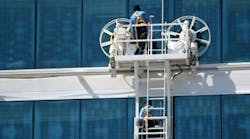By Dan Hebert, PE, Senior Technical Editor
In many cases, there's nothing mechanically wrong with a machine. It might just need a new control system. The horizontal bender at a conduit manufacturer is a good example, says Brian Engle, design engineer at Industrial Technology Solutions (ITS). The bender was controlled with manually operated hydraulic valves manipulated by two operators to achieve the necessary bend angle. They used a hard limit switch to control the travel of the bending die. Travel had to be adjusted constantly for variations in the pipe size and inconsistencies in the material.
Operators needed to make several precise smaller bends while moving the pipe forward in the shoe. This process of segment bending needs very precise control to achieve a quality product. The setup time was long and there was a tremendous amount of scrap produced before good product could roll off.
"The bender is used for most of their custom work," Engle says. "If a job calls for, say, making 90° elbows with a 60 in. radius from 2 in. galvanized rigid conduit, there is no standard shoe for that. So this machine is used to make small quantities of non-standard products."
ITS modernized the control system with an HMI, PLC and sensors. "Our system uses a magnetic encoder on the bending die to track bend angle while analyzing the bending shoe to compensate for pipe inconsistency and spring back," Engle explains. "There is also a linear cable position encoder that allows the bending shoe to measure pressure or positioning sensing. The HMI is an integral part of the process as the gateway for the operators to interface with the PLC. Advanced diagnostics limit downtime and optimize setup procedures to provide maximum product output." In this case, the user can measure the improvement in TCO directly in terms of reduced scrap, reduced labor for setup and operation, and quicker turnaround on custom jobs.
Operating any automated machine should be fairly simple, Engle says, despite the underlying complexity of the control system. "There's no need to provide a complex solution to a simple problem," he says. "Troubleshooting a machine can be a daunting task for most plant personnel. We try not to overcomplicate that process with unnecessary sophistication. When the situation demands it, a more complex control system can be implemented and easily justified by its advanced diagnostics and intuitive interfacing techniques."




